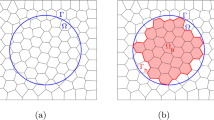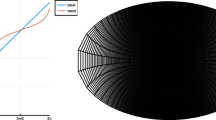Abstract
In this paper, we develop fully discrete methods for two molecular beam epitaxial models on surfaces, where one has a fourth-order Ginzburg–Landau double-well potential, and the other has a logarithmic nonlinear potential. The main challenge is how to establish high-order spatiotemporal accurate schemes with the property of unconditional energy stability. The spatial numerical approach adopted in this paper is the recently developed isogeometric analysis framework based on loop subdivision technology, where it can provide an exact and elegant description for the surfaces with arbitrary topology, and subdivision basis functions can serve to represent the numerical solutions. The temporal discrete scheme is based on the “explicit-invariant energy quadratization” strategy. Its novelty is to introduce two auxiliary variables (one local and the other nonlocal) and then develop two specific ordinary differential equations that convert the original equations into their equivalent forms. The use of the nonlocal variable helps us avoid dealing with variable coefficients and solve only equations with constant coefficients, and the use of the local variable allows us to obtain linear schemes with energy-stable structures numerically. We further perform various numerical experiments on some well-known complex surfaces, such as the sphere, bubble, and splayed surface to verify the stability and accuracy of the developed method.











Similar content being viewed by others
References
Schneider M, Schuller IK, Rahman A (1987) Epitaxial growth of silicon: a molecular-dynamics simulation. Phys Rev B 46:1340–1343
Clarke S, Vvedensky DD (1987) Origin of reflection high-energy electron-diffraction intensity oscillations during molecular-beam epitaxy: a computational modeling approach. Phys Rev Lett 58:2235–2238
Gyure MF, Ratsch C, Merriman B, Caflisch RE, Osher S, Zinck JJ, Vvedensky DD (1998) Level-set methods for the simulation of epitaxial phenomena. Phys Rev E 58(3):6927–6930
Shen J, Tang T, Yang J (2016) On the maximum principle preserving schemes for the generalized Allen–Cahn equation. Commun Math Sci 14:1517–1534
Shen J, Yang X (2010) Numerical approximations of Allen–Cahn and Cahn–Hilliard equations. Discrete Contin Dyn Syst 228:1669–1691
Zhao J, Wang Q, Yang X (2016) Numerical approximations to a new phase field model for immiscible mixtures of nematic liquid crystals and viscous fluids. Comput Methods Appl Mech Eng 310:77–97
Eyre DJ (1998) Unconditionally gradient stable time marching the Cahn–Hilliard equation. In: Computational and mathematical models of microstructural evolution. San Francisco, CA, 1998, Materials research society symposium proceedings, vol 529. MRS, Warrendale, PA, pp 39–46
Wang C, Wang X, Wise SM (2010) Unconditionally stable schemes for equations of thin film epitaxy. Discrete Contin Dyn Syst 28(1):405–423
Shen J, Wang C, Wang X, Wise SM (2012) Second-order convex splitting schemes for gradient flows with Ehrlich–Schwoebel type energy: application to thin film epitaxy. SIAM J Numer Anal 50(1):105–125
Chen W, Conde S, Wang C, Wang X, Wise S (2012) A linear energy stable scheme for a thin film model without slope selection. J Sci Comput 52:546–562
Yang X, Zhao J, Wang Q (2017) Numerical approximations for the molecular beam epitaxial growth model based on the invariant energy quadratization method. J Comput Phys 333:104–127
Chen L, Zhao J, Yang X (2018) Regularized linear schemes for the molecular beam epitaxy model with slope selection. Appl Numer Math 128:139–156
Shen J, Yang X (2020) The IEQ and SAV approaches and their extensions for a class of highly nonlinear gradient flow systems. Contemp Math 754:217–245
Yang X (2021) A novel fully-decoupled scheme with second-order time accuracy and unconditional energy stability for the Navier–Stokes equations coupled with mass-conserved Allen–Cahn phase-field model of two-phase incompressible flow. Int J Numer Methods Eng 122:283–1306
Yang X, Zhang G-D (2020) Convergence analysis for the invariant energy quadratization (IEQ) schemes for solving the Cahn–Hilliard and Allen–Cahn equations with general nonlinear potential. J Sci Comput 82:55
Yang X (2021) Numerical approximations of the Navier-Stokes equation coupled with volume-conserved multi-phase-field vesicles system: fully-decoupled, linear, unconditionally energy stable and second-order time-accurate numerical scheme. Comput Methods Appl Mech Eng 375:113600
Yang X (2016) Linear, first and second order and unconditionally energy stable numerical schemes for the phase field model of homopolymer blends. J Comput Phys 302:509–523
Yang X, Yu H (2018) Efficient second order unconditionally stable schemes for a phase-field moving contact line model using an invariant energy quadratization approach. SIAM J Sci Comput 40:889–914
Yang X, Zhao J, Wang Q, Shen J (2017) Numerical for a three components Cahn–Hilliard phase-field model based on the invariant energy quadratization method. Math Models Methods Appl Sci 27(11):1993–2030
Zhao J, Yang X, Gong Y, Wang Q (2017) A novel linear second order unconditionally energy stable scheme for a hydrodynamic Q-tensor model of liquid crystals. Comput Methods Appl Mech Eng 318:803–825
Furihata D (2001) A stable and conservative finite difference scheme for the Cahn–Hilliard equation. Numer Math 87:675–699
Lee HG, Lowengrub JS, Goodman J (2002) Modeling pinchoff and reconnection in a Hele–Shaw cell. II. Analysis and simulation in the nonlinear regime. Phys Fluids 14:514–545
Liu C, Shen J (2003) A phase field model for the mixture of two incompressible fluids and its approximation by a Fourier-spectral method. Physica D 179:211–228
Dziuk G, Elliot CM (2013) Finite element methods for surface PDEs. Acta Numer 22:289–396
Zhao S, Xiao X, Feng X (2020) An efficient time adaptively based on chemical potential for surface Cahn–Hilliard equation using finite element approximation. Appl Math Comput 369:124901
Du Q, Ju L, Tian L (2011) Finite element approximation for the Cahn–Hilliard equation on surface. Comput Methods Appl Mech Eng 200:2458–2470
Marenduzzo D, Orlandini E (2013) Phase separation dynamics on curved surfaces. Soft Matter 9:1178–1187
Hughes TJR, Cottrell JA, Bazilevs Y (2005) Isogeometric analysis: CAD, finite elements, NURBS, exact geometry, and mesh refinement. Comput Methods Appl Mech Eng 194:4135–4195
Bazilevs Y, Beirão da Veiga L, Cottrell JA, Hughes TJR, Sangalli G (2006) Isogeometric analysis: approximation, stability and error estimates for h-refined meshes. Math Models Methods Appl Sci 16(7):1031–1090
Piegl LA, Tiller W (1997) The Nurbs book (monographs in visual communication), 2nd edn. Spinger, New York
Sederberg TW, Finnigan GT, Li X, Lin H, Ipson H (2008) Watertight trimmed NURBS. ACM Trans Graph 27(3):1–8
Zhang Y, Bazilevs Y, Goswami S, Bajaj C, Hughes TJR (2007) Patient-Specific vascular NURBS modeling for isogeometric analysis of blood flow. Comput Methods Appl Mech Eng 196(29–30):2943–2959
Sederberg TW, Zheng J, Bakenov A, Nasri A (2003) T-splines and T-NURCCs. ACM Trans Graph 22(3):477–484
Bazilevs Y, Calo VM, Cottrell JA, Evans JA, Hughes TJR, Lipton S, Scott MA, Sederberg TW (2010) Isogeometric analysis using T-splines. Comput Methods Appl Mech Eng 5–8:229–263
Catmull E, Clark J (1978) Recursively generated B-spline surfaces on arbitrary topological meshes. Comput Aided Des 10(6):350–355
Loop C (1978) Smooth subdivision surfaces based on triangles. Master’s thesis. Department of Mathematics, University of Utah
Stam J (1998) Fast evaluation of Catmull–Clark subdivision surfaces at arbitrary parameter values. In: SIGGRAPH ’98 proceedings, pp 395–404
Stam J (1998) Fast evaluation of Loop triangular subdivision surfaces at arbitrary parameter values. In: SIGGRAPH ’98, CD-ROM supplement
Cirak F, Ortiz M, Schröder P (2000) Subdivision surfaces: a new paradigm for thin-shell finite-element analysis. Int J Numer Methods Eng 47:2039–2072
Cirak F, Scott MJ, Antonsson EK, Ortiz M, Schröder P (2002) Integrated modeling, finite-element analysis, and engineering design for thin-shell structures using subdivision. Comput Aided Des 34(2):137–148
Pan Q, Xu G, Xu G, Zhang Y (2015) Isogeometric analysis based on extended Loop’s subdivision. J Comput Phys 299(15):731–746
Pan Q, Xu G, Xu G, Zhang Y (2016) Isogeometric analysis based on extended Catmull–Clark subdivision. Comput Math Appl 71:105–119
Pan Q, Chen C, Xu G (2017) Isogeometric finite element approximation of minimal surfaces based on extended Loop subdivision. J Comput Phys 343:324–339
Pan Q, Rabczuk T, Xu G, Chen C (2018) Isogeometric analysis of minimal surfaces on the basis of extended Catmull–Clark subdivisions. Comput Methods Appl Mech Eng 337:128–149
Pan Q, Rabczuk T, Xu G, Chen C (2019) Isogeometric analysis for surface PDEs with extended Loop subdivision. J Comput Phys 398:108892
Pan Q, Rabczuk T, Yang X (2021) Subdivision-based isogeometric analysis for second order partial differential equations on surfaces. Comput Mech 68:1205–1221
Pan Q, Rabczuk T, Chen C (2022) Subdivision based isogeometric analysis for geometric flows. Int J Numer Methods Eng 123:610–633
Do Carmo MP (1976) Differential geometry of curves and surfaces. Prentice-Hall, Englewood Cliffs
Spivak MA (1999) A comprehensive introduction to differential geometry, vol 3, 3rd edn. Perish, Boston
Moldovan D, Golubovic L (2000) Interfacial coarsening dynamics in epitaxial growth with slope selection. Phys Rev E 61:6190–6214
Ehrlich G, Hudda FG (1966) Atomic view of surface diffusion: tungsten on tungsten. J Chem Phys 44:1036
Schwoebel RL (1969) Step motion on crystal surfaces: II. J Appl Phys 40:614
Kobbelt L, Hesse T, Prautzsch H, Schweizerhof K (1997) Iterative mesh generation for FE-computation on free form surfaces. Eng Comput 14:806–820
Dyn N, Levin D, Gregory JA (1990) A butterfly subdivision scheme for surface interpolation with tension control. ACM Trans Graph 9(2):160–169
Zorin D, Schröder P, Sweldens W (1996) Subdivision for meshes with arbitrary topology. In: SIGGRAPH ’96 proceedings, pp 71–78
Doo D, Sabin M (1978) Behaviours of recursive division surfaces near extraordinary points. Comput Aided Des 10(6):356–360
Peters J, Reif U (1997) The simplest subdivision scheme for smoothing polyhedra. ACM Trans Graph 16(4):420–431
Zhang H, Zhang J, Yang X (2021) Stabilized invariant energy quadratization (S-IEQ) method for the molecular beam epitaxial model without slope section. Int J Numer Anal Model 18:642–655
Cheng Q, Shen J, Yang X (2019) Highly efficient and accurate numerical schemes for the epitaxial thin film growth models by using the SAV approach. J Sci Comput 78:1467–1487
Kohn RV, Yan X (2003) Upper bound on the coarsening rate for an epitaxial growth model. Commun Pure Appl Math 56:1549–1564
Li B, Liu JG (2003) Thin film epitaxy with or without slope selection. Eur J Appl Math 14:713–743
Wang C, Wang X, Wise SM (2010) Unconditionally stable schemes for equations of thin film epitaxy. Discrete Contin Dyn Syst 28(1):405–423
Acknowledgements
The work of Q. Pan was partially supported by National Natural Science Foundation of China (Nos. 12171147 and 12261017). The work of J. Zhang was partially supported by Hunan Provincial Natural Science Foundation of China (No. 2021JJ30456). The work of X. Yang was partially supported by National Science Foundation of USA with Grant Number DMS-2012490.
Author information
Authors and Affiliations
Corresponding author
Additional information
Publisher's Note
Springer Nature remains neutral with regard to jurisdictional claims in published maps and institutional affiliations.
Rights and permissions
Springer Nature or its licensor (e.g. a society or other partner) holds exclusive rights to this article under a publishing agreement with the author(s) or other rightsholder(s); author self-archiving of the accepted manuscript version of this article is solely governed by the terms of such publishing agreement and applicable law.
About this article
Cite this article
Pan, Q., Zhang, J., Rabczuk, T. et al. Numerical algorithms of subdivision-based IGA-EIEQ method for the molecular beam epitaxial growth models on complex surfaces. Comput Mech 72, 927–948 (2023). https://doi.org/10.1007/s00466-023-02319-6
Received:
Accepted:
Published:
Issue Date:
DOI: https://doi.org/10.1007/s00466-023-02319-6




